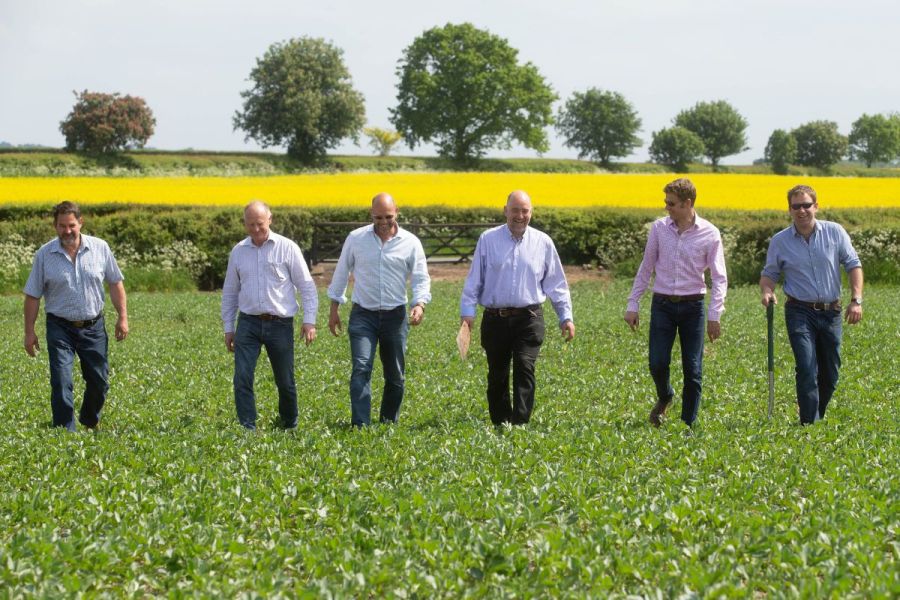Citizen science was a theme that wove its way through the recent Green Farm Collective conference. CPM was there to hear how this group of pioneering regenerative farmers is sharing their knowledge, but also how the way food is grown may impact its nutritional quality and how this relates to human and soil health.
“Soil and foliar microorganisms effectively invented plants and have evolved to look after them.”
By Lucy de la Pasture
Often farmers consider themselves to be mere minnows in an ocean, where they’re driven by strong currents and not in control of their own destiny. The Green Farm Collective could be said to be swimming against the tide in their mission to get closer to their customers and farm in a way that puts nature at its heart.

For the second year, Michael Kavanagh hosted the Green Farm Collective conference at Church Farm, near Shifnal in Shropshire.
Opening the conference, host farmer and CPM’s Climate Change Champion in 2022, Michael Kavanagh told delegates that one of the purposes behind forming the Green Farm Collective was to bring additional income on to farm through the private sector but it’s a much wider mission than that, bringing together like-minds and empowering farmers.
“Initially, we’re trying to share knowledge and help other farmers on the same journey. We’re looking to trade carbon and obtain premium prices. We’re privately trading biodiversity and we’re also marketing regeneratively farmed produce with the firm belief there should be a premium attached.”
As a further development to the Green Farm Collective brand, the group has been working with Food Integrity Assurance and, from September, members will be certifiable as genuine Green Farm Collective regenerative producers, added Michael.
“We have food production alongside nature, and we’re really trying to prove the point that we can farm profitably in this way while undoing some of the harm that humans have done to the biodiversity of this planet.”
Fellow Green Farm Collective founder member Tim Parton described his regenerative journey and how that’s led to minimal use of herbicides, no insecticides, fungicides or growth regulators at nearby Brewood Park Farm. Instead, Tim employs biology and nutrition and to such good effect that yields haven’t reduced on the farm.
“I try and farm with the heartbeat of Mother Nature,” he said. “My journey started in 2009 when I started strip tilling. I began playing with biology in 2012, born out of a fascination that bacteria can fix nitrogen from the air. Since then I’ve found biology has all the answers, you just have to ask the right questions.”
In the first year using biology on his wheat, Tim found a yield increase and although this wasn’t repeated in the second year, he reckoned he was on to something. But he warns that biology can be a fickle thing, it’s affected by temperature and environmental conditions, and that’s why he aligns his farming with nature – altering his approaches to the season.
Three years later a John Deere 750A direct drill arrived at the farm, completing the journey to no-till. But Tim didn’t stop there, his drill features a number of modifications which allow him to fine-tune his approaches and to give versality when it comes to planting companion or cover crops.
“We developed a liquid system so we could put biology directly on top of the seed, which is home-saved so it’s colonised with adapted, native endophytes. This has evolved from a simple diaphragm pump to a peristaltic system, which is better able to deal with the biofilms we produce when brewing biology,” he told delegates.
Tim has refined his brewing process over the years and has learned to work with biology to get the best out of it. For example, he heats the water for his brew to 18⁰C before he adds biology rather than using cold water, which isn’t optimal for the microbes to replicate.
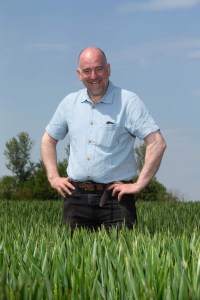
Tim Parton is pioneering farming successfully using just biology and nutrition which he described as farming with the heartbeat
of nature.
He combines his biological farming with close attention to plant nutrition, recognising environmental conditions aren’t always optimal for microbes to release the nutrients from the soil to supply nutrition to the crop. And when this happens, he’s ready to step in with the appropriate foliars.
“I do a lot of SAP testing. If it’s too dry, then biology stops working so that’s when I can make an informed decision and apply foliar nutrition.”
Organic amino acids play a big role in Tim’s agronomy. “The crop doesn’t have to use as much energy to convert amino acids into a usable form of nitrogen and it’s also a source of carbon. But I do apply ammonium nitrate at the beginning of the season to stimulate the biology,” he said.
For those just starting on the regenerative journey, Tim gave some sage advice. “Change is never easy. It’s a challenge mentally and I found it quite isolating as when I started, everybody said I was mad and nobody wanted to talk farming with me. And that’s hard. You have to just keep focusing on where you want to go.
“I always use the analogy; it’s like swimming across a river, and you start to get tired and look back at the bank. My advice is, don’t. Remember where you want to be and what you’re trying to achieve. Remember, you want to do this for generations to come and soil is your most valuable resource.”
Tim is passionate about producing food that’s good for you and packed with nutrients while at the same time healing the land. “We now have the knowledge to repair the damage that has been done, and farm while healing the planet,” he concluded.
Eddie Bailey of Ryzophyllia took a deep dive into soil biology at a microscopic level, explaining that it’s the microbes that work to provide the plants with optimal nutrition, for themselves but ultimately for the greater good of the planet and all on board it.

Eddie Bailey gave a fascinating insight into soil biology, how plants evolved and the plant-microbial relationships this has resulted in.
Regenerative farmers are often talking about the ratio of fungi to bacteria in their soils, with the goal of increasing the former, but how does this impact on crops?
“A degraded soil contains little biology other than bacteria,” explained Eddie. “Certain bacteria decompose organic matter to ammonia, but other types then immediately convert the ammonia to nitrate. Most food crops require a balance of ammonia and nitrate and in a bacterial dominated soil most plants will have to use precious energy converting nitrate to ammonium.”
The role of soil microbes has largely been forgotten in modern agriculture but they actually play a vital role in the metabolism of plants and humans, and are intimately connected with nutrients.
“Bacteria produce rubisco (ribulose biphosphate carboxylase/oxygenase), which is the most abundant enzyme on Earth and is used in photosynthesis to split the CO2 molecule. It’s fundamental to aerobic life and was created by bacteria nearly 4 billion years ago,” explained Eddie.
Bacteria also produce the enzyme superoxide dismutase (SOD). “Aerobic life wouldn’t exist without it,” explained Eddie. “Respiration and photosynthesis unavoidably produce DNA-shattering Reactive Oxygen Species (ROS), such as superoxide. It’s a trade-off for the extra energy obtain from aerobic respiration, but overproduction can be a major health risk and so early bacteria developed their own antioxidant, SOD, which is a bacterial adaptation to break down the superoxide.”
These are just some of the enzymes that bacteria produce that are essential to life, but these microbes also have a role in plant nutrition. “There’s the incredible rhizophagy cycle, where bacteria offer up their nutrient-rich cell walls to assist in plant nutrition,” he explained.
“Bacteria (mostly pseudomonads) produce secretions to which the plant reacts by releasing superoxide that strip the bacteria naked but doesn’t kill them. Instead, the bacteria move away from the root meristem and secrete the growth hormone ethylene, which causes root hairs to grow and they then escape through them back into the soil solution. Here, the bacteria reform their cells wall and go back for more. The degraded cells walls are an internalised source of nitrogen and phosphorus and many other elements for the plant.”
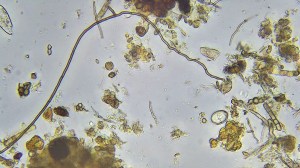
The world beneath our feet is literally teeming with life that’s fundamental to the well-being of not just the soil, but the planet.
And soil life doesn’t stop giving there – it plays a role in nutrient sequestration via the organic acids of mycorrhizal fungi, in nutrient balancing and cycling (eg C:N), endophytes, phosphorous solubilizing phosphatases via microbial acidification, iron chelation (siderophores), soil structure – micro and macro-aggregates improving drainage and gas exchange, antibiotics from actinobacteria such as Streptococcus, water supply via mycorrhizal fungi, decomposition enyzmes (hydrolases, proteases, cellulases, chitinases, as well organic acids), and lignin-modifying enzymes.
“At least 90% of plants have mycorrhizal relationships, and 100% of plants benefit from intimate bacterial associations. Plants fundamentally rely on microbial helpers to manufacture enzymes and organic acids to do as much of the hard work as possible.
“We know that plants recruit specialised ‘consortia’ of soil microbes using specific exudate attractants relative to the growth stage of the plant because they deliver specific services and substances most in need of at that time. For instance, cyanobacteria are sought during bolting and flowering because of the need for extra nitrogen,’ he explained.
Eddie summed up by looking back in time at how plants evolved to explain why microbes are so closely associated with them. “Genomic studies indicate that some 580M years ago, a streptophyte algae was provided with genes that protected it against desiccation; the gene-donating organism was an endophytic bacterium and it obtained glucose and protection in return.
“100M years later a fungus joined the party, obtaining glucose in return for an abundance of minerals from the Earth’s crust via its extraordinary array of organic acids. And the fungi gained access to a limitless supply of photosynthates. Land plants, at the very least, were the inevitable consequence of this union, enabling colonisation of all parts of the terrestrial world.
“Soil and foliar microorganisms, especially bacteria and fungi, fundamentally underpin the healthy growth of plants. They effectively invented plants and have evolved to look after them. If we notice malnutrition, pathogenesis and pests affecting our crops, then we must first and foremost consider what might have happened to break the microbial bridge between soil and plants.”
Eddie believes pathogens get bad press as they’re simply recycling due to something growers got wrong or where the crop was struggling under adverse environmental conditions. “Taking the former, if we notice stunted growth and reddened leaves then we might diagnose phosphorous deficiency but who’s to blame if there are few phosphorous-solubilising bacteria in the soil or for the soil becoming too alkaline due to the overuse of synthetic fertilisers?
“By extension, the phosphorous-deficient plant will lack the strength to earn its place for the benefit of the rest of the food chain and so ‘nature’ will act to degrade it via fungi and bacteria, making its nutrients available for the next generation.
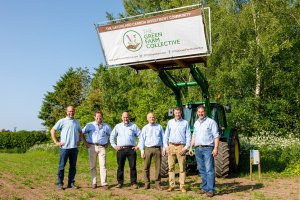
The Green Farm Collective is a group of six regenerative farmers who came together in 2021 to bring additional income on to farm through the private sector, bring together like-minds and empower farmers.
“Taking the latter, in a long period of drought, for example, a plant decides to cut its losses and set seed sooner rather than miss the chance. By leaf-abscission the plant saves energy and allows microbes (so-called pathogens) to degrade and recycle the leaf.
“In my experience, the two most important breaks in the soil food web are carbon-food, and water related. We must periodically feed the microbes with good quality compost and teas, and ensure they don’t dry out. Everything in moderation.”
Something often claimed by regenerative farmers is that their produce is more nutrient dense and therefore better for you. But what’s the story behind this? Matthew Adams of Growing Real Food For Nutrition (Grffn) called for farmers to join Tim Parton and sign up to a citizen science project to test food with the US-developed Bionutrient meter, which uses spectroscopy to analyse nutrient density.
The aim of Grffn is to create a community of growers, chefs, nutritionists and food citizens to measure food for nutrient density in a citizen science project that will provide information on the quality of the soil it was grown in – linking the nutritional quality of food to soil health.
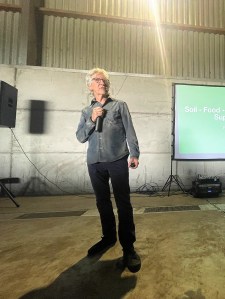
Patrick Holford makes the connection between human health and nutrition, highlighting the importance of the way food is grown.
“We know from Brix testing that values are higher in naturally farmed compared with chemically farmed food. This is borne out in blind taste testing, where more people selected naturally grown food as better tasting,” says Matthew.
“By gathering experiential data – such as taste tasting and observing the incidence of pests and diseases and relating these to measurements of nutritional density – this citizen science could help reevaluate the Brix tables, which were devised in the 1970s, and revise them if necessary.”
Keynote speaker Patrick Holford brought together all the strands of the conference in his session which considered the soil-food-gut-brain superhighway and how nutrition affects human health. There’s a synergy between his discoveries about the relationship between nutrition and disease and the food produced by regenerative growers who focus on the health of the soil microbiome. And it’s the partnership between the soil’s microbiome and the plant, which transfers and magnifies nutrient content, that has turned Patrick’s attention to how food is actually grown.
Citizen science could soon be unearthing the evidence that regeneratively grown food is the way forward for human health.
This article was taken from the latest issue of CPM. For more articles like this, subscribe here.
Sign up for Crop Production Magazine’s FREE e-newsletter here.

